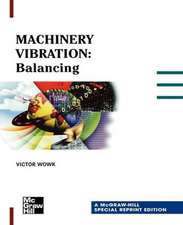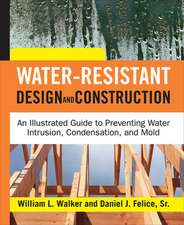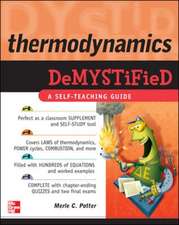One-Dimensional Finite Elements: An Introduction to the FE Method
Autor Andreas Öchsner, Markus Merkelen Limba Engleză Paperback – 9 noi 2014
The approach using only one-dimensional elements covers not only standard problems but allows also for advanced topics like plasticity or the mechanics of composite materials. Many examples illustrate the concepts and problems at the end of every chapter help to familiarize with the topics.
| Toate formatele și edițiile | Preț | Express |
|---|---|---|
| Paperback (3) | 412.59 lei 38-44 zile | |
| Springer – 9 noi 2014 | 412.59 lei 38-44 zile | |
| Springer International Publishing – 26 dec 2018 | 591.14 lei 6-8 săpt. | |
| Springer Berlin, Heidelberg – 29 dec 2023 | 709.58 lei 6-8 săpt. | |
| Hardback (2) | 401.24 lei 6-8 săpt. | |
| Springer Berlin, Heidelberg – 6 oct 2012 | 401.24 lei 6-8 săpt. | |
| Springer International Publishing – 7 mai 2018 | 653.98 lei 6-8 săpt. |
Preț: 412.59 lei
Preț vechi: 515.74 lei
-20% Nou
Puncte Express: 619
Preț estimativ în valută:
78.97€ • 85.81$ • 66.38£
78.97€ • 85.81$ • 66.38£
Carte tipărită la comandă
Livrare economică 17-23 aprilie
Preluare comenzi: 021 569.72.76
Specificații
ISBN-13: 9783642440977
ISBN-10: 3642440975
Pagini: 424
Dimensiuni: 155 x 235 x 22 mm
Greutate: 0.59 kg
Ediția:2013
Editura: Springer
Colecția Springer
Locul publicării:Berlin, Heidelberg, Germany
ISBN-10: 3642440975
Pagini: 424
Dimensiuni: 155 x 235 x 22 mm
Greutate: 0.59 kg
Ediția:2013
Editura: Springer
Colecția Springer
Locul publicării:Berlin, Heidelberg, Germany
Public țintă
Upper undergraduateCuprins
Motivation
for
the
Finite
Element
Method.-
Bar
Element.-
Torsion
bar.-
Bending
Element.-
General
1D
Element.-
Plane
and
Spatial
Frame
Structures.-
Beam
with
Shear
Contribution.-
Beams
of
Composite
Materials.-
Nonlinear
Elasticity.-
Plasticity.-
Stability
(Buckling).-
Dynamics.
Recenzii
From
the
reviews:
“As its title describes, this book is about the finite element method applied to one-dimensional problems. … several problems of interest are indeed modeled using a single space variable. This book should appeal to the mechanical engineering community.” (Alexandre L. Madureira, Mathematical Reviews, January, 2014)
“This book is an excellent addition to course resources on finite elements. … Each chapter includes worked examples and a few exercise problems. Short answers for the exercises, provided at the end of the book, will be helpful to students. A valuable course resource for students in mechanical, civil, aerospace, and other engineering curricula and a useful acquisition for academic libraries. Summing Up: Highly recommended. Upper-division undergraduates, graduate students, practicing engineers.” (R. Kolar, Choice, Vol. 51 (1), September, 2013)
“As its title describes, this book is about the finite element method applied to one-dimensional problems. … several problems of interest are indeed modeled using a single space variable. This book should appeal to the mechanical engineering community.” (Alexandre L. Madureira, Mathematical Reviews, January, 2014)
“This book is an excellent addition to course resources on finite elements. … Each chapter includes worked examples and a few exercise problems. Short answers for the exercises, provided at the end of the book, will be helpful to students. A valuable course resource for students in mechanical, civil, aerospace, and other engineering curricula and a useful acquisition for academic libraries. Summing Up: Highly recommended. Upper-division undergraduates, graduate students, practicing engineers.” (R. Kolar, Choice, Vol. 51 (1), September, 2013)
Notă biografică
Andreas
Öchsner,
born
1970,
is
Full
Professor
in
the
Department
Solid
Mechanics
and
Design
at
the
University
of
Technology
Malaysia
(UTM),
Malaysia
and
Head
of
the
Advanced
Materials
and
Structure
Lab.
Having
obtained
a
Diploma
Degree
(Dipl.-Ing.)
in
Aeronautical
Engineering
at
the
University
of
Stuttgart
(1997),
Germany,
he
spent
the
time
from
1997-2003
at
the
University
of
Erlangen-Nuremberg
as
a
research
and
teaching
assistant
to
obtain
his
Doctor
of
Engineering
Sciences
(Dr.-Ing.).
From
2003-2006,
he
worked
as
Assistant
Professor
in
the
Department
of
Mechanical
Engineering
and
Head
of
the
Cellular
Metals
Group
affiliated
with
the
University
of
Aveiro,
Portugal.
His
research
interests
are
related
to
experimental
and
computational
mechanics,
cellular
metals
and
thin
structures
and
interphases.
He
has
published
over
290
scientific
publications,
comprising
11
research
monographs,
13
book
chapters
and
one
teaching
book
on
finite
element
methods.
He
is
the
general
chairman
of
six
international
conferences
on
computational
and
experimental
engineering
(ACE-X
series)
and
eight
international
conferences
in
the
area
of
heat
and
mass
transfer
(DSL
series).
His
editorial
work
comprises
posts
as
Editor-in-chief
of
the
international
journal
Continuum
Mechanics
and
Thermodynamics
(Springer),
Editor-in-chief
of
the
Springer
book
series
on
Advanced
Structured
Materials
and
Editor
of
SpringerBriefs
in
Applied
Sciences
and
Technology:
Computational
Mechanics.
His
research
activities
were
recognised
in
2010
by
the
award
of
a
higher
doctorate
degree
(D.Sc.)
by
the
University
of
Newcastle,
Australia.
MARKUS MERKEL, born 1967, is Full Professor at Aalen University of Applied Sciences. He graduated 1993 at the University of Erlangen-Nuremberg (Germany) in Mechanical Engineering and finished his PhD-studies in 1998. Between 1999 and 2004, Markus Merkel worked at the International Technical Development Centre of Adam Opel AG. He became Professer in 2004 for Engineering Design and Computational Mechanics at the Faculty of Mechanical Engineering and Materials Science. Markus Merkel is Head of the Institute of Virtual Product Development.
MARKUS MERKEL, born 1967, is Full Professor at Aalen University of Applied Sciences. He graduated 1993 at the University of Erlangen-Nuremberg (Germany) in Mechanical Engineering and finished his PhD-studies in 1998. Between 1999 and 2004, Markus Merkel worked at the International Technical Development Centre of Adam Opel AG. He became Professer in 2004 for Engineering Design and Computational Mechanics at the Faculty of Mechanical Engineering and Materials Science. Markus Merkel is Head of the Institute of Virtual Product Development.
Textul de pe ultima copertă
This
textbook
presents
finite
element
methods
using
exclusively
one-dimensional
elements.
The
aim
is
to
present
the
complex
methodology
in
an
easily
understandable
but
mathematically
correct
fashion.
The
approach
of
one-dimensional
elements
enables
the
reader
to
focus
on
the
understanding
of
the
principles
of
basic
and
advanced
mechanical
problems.
The
reader
easily
understands
the
assumptions
and
limitations
of
mechanical
modeling
as
well
as
the
underlying
physics
without
struggling
with
complex
mathematics.
But
although
the
description
is
easy
it
remains
scientifically
correct.
The approach using only one-dimensional elements covers not only standard problems but allows also for advanced topics like plasticity or the mechanics of composite materials. Many examples illustrate the concepts and problems at the end of every chapter help to familiarize with the topics.
The approach using only one-dimensional elements covers not only standard problems but allows also for advanced topics like plasticity or the mechanics of composite materials. Many examples illustrate the concepts and problems at the end of every chapter help to familiarize with the topics.
Caracteristici
Introduces
a
new
educational
approach
using
only
one-dimensional
elements
Uses intuitive mathematics and is scientifically exact
Describes also advanced problems like composite materials and nonlinear elasticity
Many examples facilitate the understanding plus solutions manual for instructors
Uses intuitive mathematics and is scientifically exact
Describes also advanced problems like composite materials and nonlinear elasticity
Many examples facilitate the understanding plus solutions manual for instructors
Descriere
Presenting
a
complex
methodology
in
an
easily
understandable
but
mathematically
correct
fashion,
this
book
reviews
finite
element
methods
using
exclusively one-dimensional
elements.
Advanced
topics
include
plasticity
and
the
mechanics
of
composite
materials.













